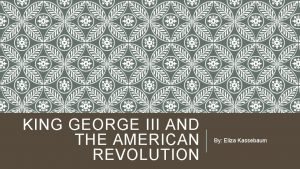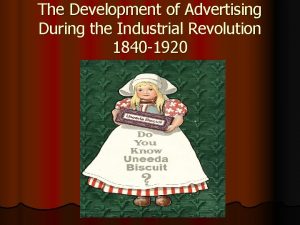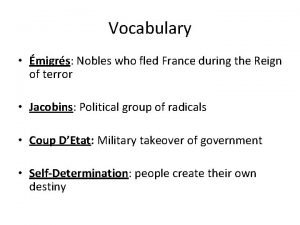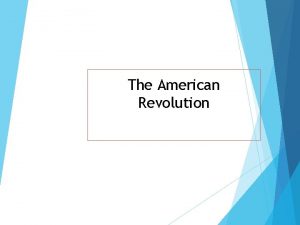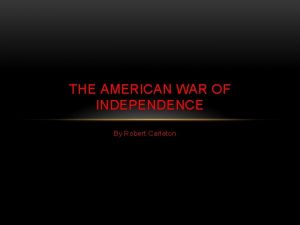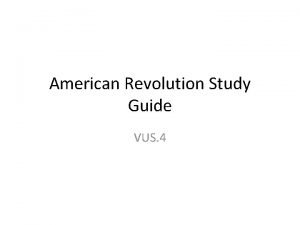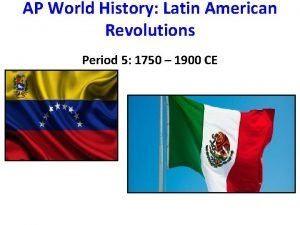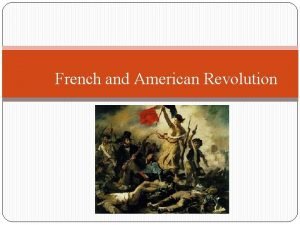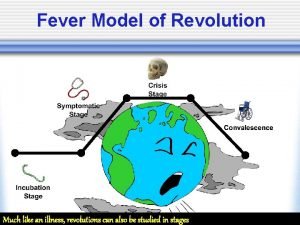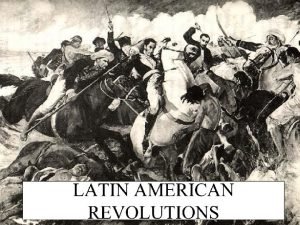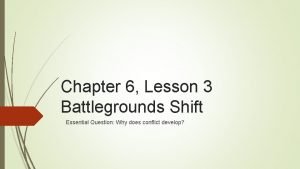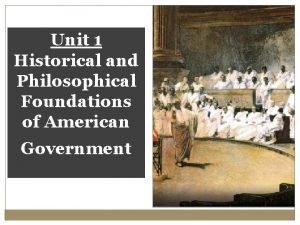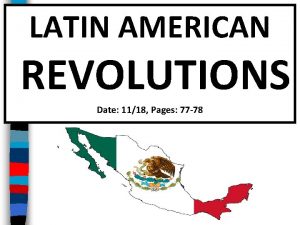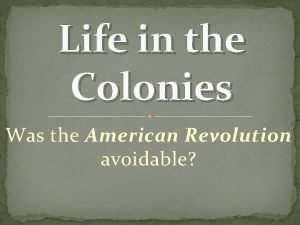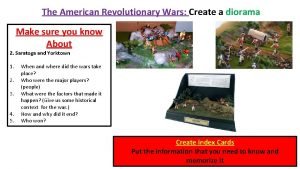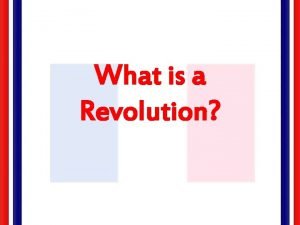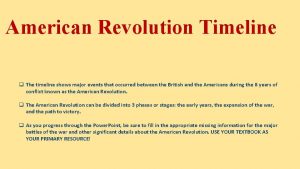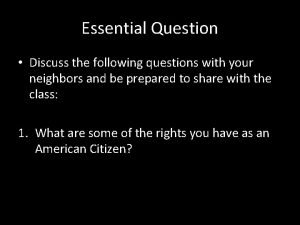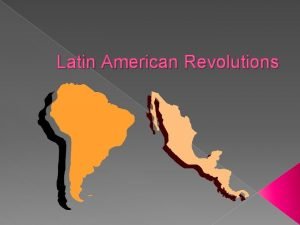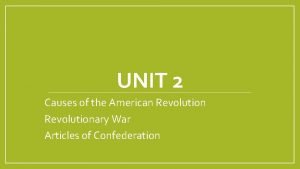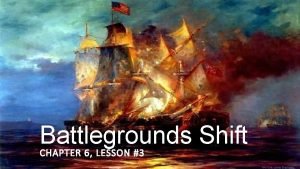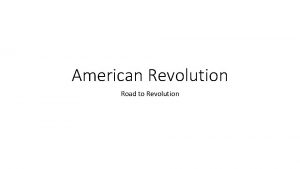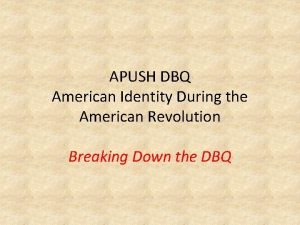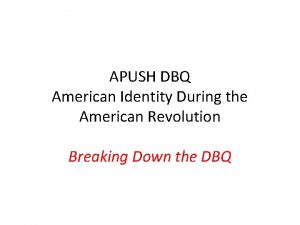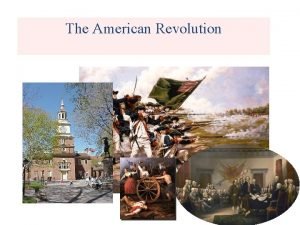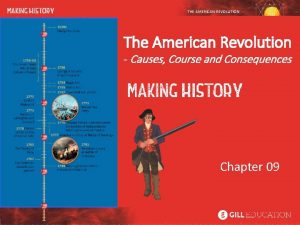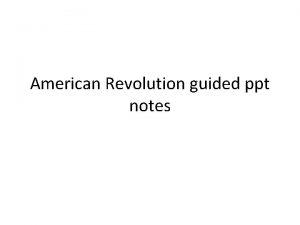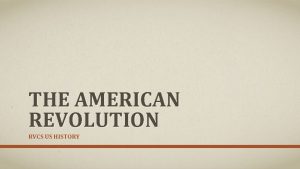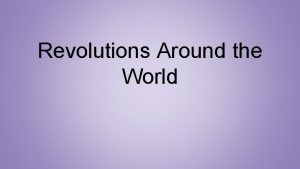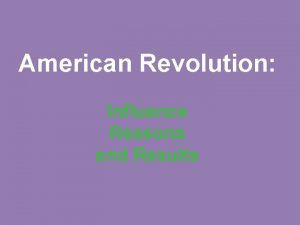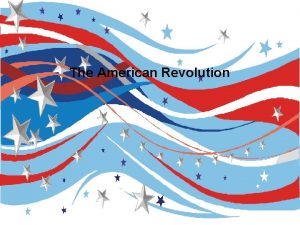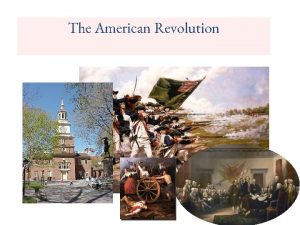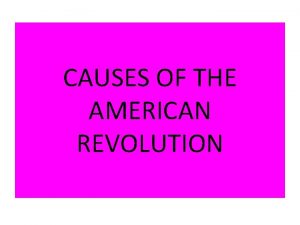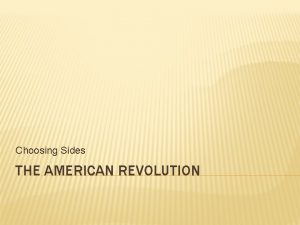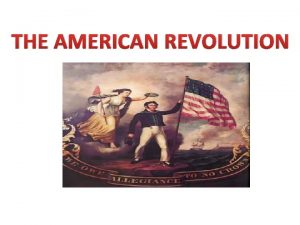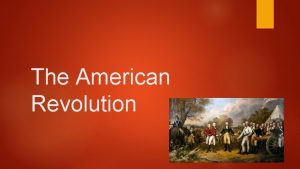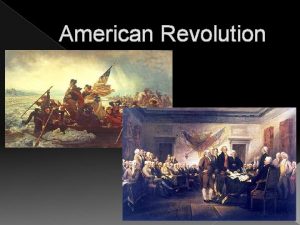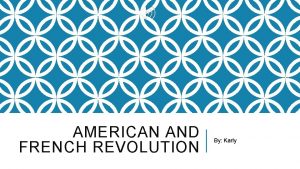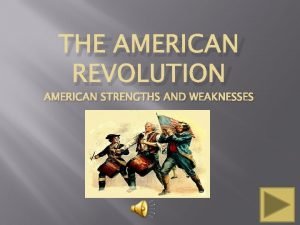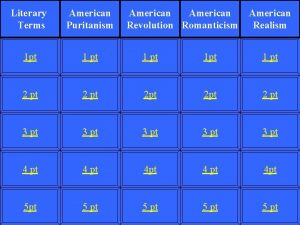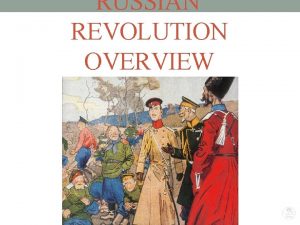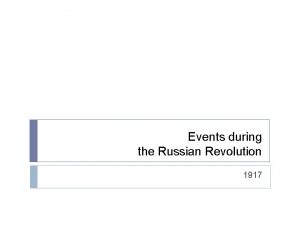The American Revolution During the American Revolution the



























- Slides: 27

The American Revolution During the American Revolution, the overmatched colonists found a leader in George Washington and badly-needed French assistance after the Battle of Saratoga. When the war ended, the Treaty of Paris in 1783 brought independence and the formation of the United States. https: //www. youtube. com/watch? v=3 Ei. Sym. Rr. KI 4 https: //www. youtube. com/watch? v=p 8 Bw. WBc 571 k

• By 1776, American colonists were divided into 3 groups: • Patriots • Loyalists • Neutral • http: //www. youtube. com/watch? v=ZTY 0 V 8 Gae. FI The Declaration of Independence

• By 1776, enough Americans were patriots that members of the Second Continental Congress formed a 5 -man committee to draft a Declaration of Independence: • Thomas Jefferson of Virginia was the principal author. • It was based on the “enlightened” ideas of John Locke and explained why the colonists were rebelling. The Declaration of Independence – July 4, 1776

• The American Revolution was inspired by the Enlightenment: • John Locke – all men are born with natural rights & citizens can revolt from tyrannical governments • Montesquieu – separation of powers; checks and balances • Thomas Paine’s Common Sense – urged colonial independence The Enlightenment

• Examine Excerpts from the Declaration of Independence Class Activity


• The Declaration of Independence was a formal demand for separation, but the Revolutionary War had already begun in 1775: • Lexington & Concord: “The shot heard around the world” • Formation of a Continental Army under George Washington • Americans were divided among Patriots, Loyalists, & neutrals The American Revolution

https: //www. youtube. com/watch? v=6 nf. Ho. XWe. ZCg

• Where were the Loyalists? • Why were Loyalists near cities? • Why are Indians Loyalists? Patriots vs. Loyalists

• When the war began, the British had a clear military advantage: • • 400% larger & more experienced army More money The world’s most dominant navy Manufacturing to make war supplies Fighting the Revolutionary War

• But the American colonists had… • • Familiarity with the environment A desire to win the war Short supply lines to their soldiers A long-term strategy to outlast the British Revolutionary War

• As Leader of the Continental Army, George Washington was the symbol of the American cause • He had to build a professional army & coordinate the militias • Encouraged common citizens & volunteer soldiers to support the war even when the British seemed destined to win during the early years of the revolution The Role of George Washington

• Continental Army • Colonial Militias • Civilians American Military

• American Strategy: Outlast the British • Defend colonial lands and prolong the war • Hit and Run tactics (guerilla tactics) • Make an alliance with France • British Strategy: Divide and Conquer • Use loyalists, seize property, encourage Indian revolts • Divide the northern and southern colonies • As long as Britain did not conquer the Continental Army, England could not win. The Americans and British had differing military strategies…

http: //www. youtube. com/watch? v=r. ZMm. PWTw. THc The American Revolution began at Lexington & Concord “The Shot Heard Around the World”

British victories from 1776 -1777 made an American victory look impossible


• On Christmas Eve 1776, Washington gave Americans hope by crossing the Delaware River & surprising British troops in Trenton, NJ • Crossing the Delaware in route to a surprise attack at Trenton & Princeton, 1776 Washington Crosses the Delaware River

• From the beginning of the war, American diplomats, led by Benjamin Franklin, tried to form an alliance with the French: • The French gov’t was willing, but needed to see that the Americans had a chance to win • The French agreed to join the American cause after the battle of Saratoga in 1777 The French Alliance

• The Battle of Saratoga was a turning point because France joined the Americans as an ally Battle of Saratoga

• After Saratoga, French General Lafayette helped train American troops while the French navy helped neutralize the British advantage on the high seas • When French troops arrived in the spring 1778, the tide of the war shifted in favor of the Americans Saratoga

• During the winter of 1777 -1778, Continental Army troops nearly starved at Valley Forge, PA but Washington & Lafayette inspired & trained the troops to continue the fight Valley Forge, PA 1777 -1778

• From 1778 -1781, both sides traded victories, but the war finally came to a conclusion at the battle of Yorktown • General Cornwallis surrendered to Washington in 1781, ending the American Revolution • Cornwallis’ surrender was the “day the world turned upside down” Yorktown

1778 -1781 Battles

• The Treaty of Paris in 1783 ended the American Revolution • The treaty gave America: • Full independence • All territory east of the Mississippi River, between Canada & Florida • The removal of the British army from U. S. claims in America The Treaty of Paris


 King during american revolution
King during american revolution King during american revolution
King during american revolution Could the french revolution have been avoided
Could the french revolution have been avoided Advertising in the industrial revolution
Advertising in the industrial revolution Working conditions during the industrial revolution
Working conditions during the industrial revolution Nobles who fled france during the revolution
Nobles who fled france during the revolution Russian revolution vs french revolution
Russian revolution vs french revolution Green revolution vs third agricultural revolution
Green revolution vs third agricultural revolution Ang batingaw by antonio molina lyrics
Ang batingaw by antonio molina lyrics 10 uncomfortable truths about the american revolution
10 uncomfortable truths about the american revolution American revolution facts
American revolution facts Road to revolution study guide answer key
Road to revolution study guide answer key Latin american revolution definition ap world history
Latin american revolution definition ap world history The effects of the french revolution
The effects of the french revolution Revolution fever model
Revolution fever model Cause of the latin american revolution
Cause of the latin american revolution The american revolution lesson 3 battlegrounds shift
The american revolution lesson 3 battlegrounds shift Philosophical foundations of the american revolution
Philosophical foundations of the american revolution Latin american revolution date
Latin american revolution date Was the american revolution avoidable
Was the american revolution avoidable American revolution diorama
American revolution diorama What is revolution
What is revolution Road to american revolution timeline
Road to american revolution timeline American french revolution venn diagram
American french revolution venn diagram Latin american revolution
Latin american revolution Main causes of the american revolution
Main causes of the american revolution Lesson 3 battlegrounds shift
Lesson 3 battlegrounds shift Chapter 6 section 4 the american revolution
Chapter 6 section 4 the american revolution
